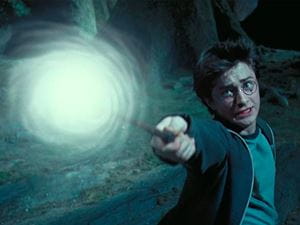
Warner Bros
“Harry Potter” is the bestselling book series of all time. It has sold more printed copies of any book except the Bible and spawned a movie series, theme park, video games, stage play, trivia games, an international sport and mountains of merchandise. Millennials and iGen tend to be more loyal to their Harry Potter house than their actual high schools. “Harry Potter” added words such as “Quidditch” and “Muggle” to the average vernacular and revolutionized the fantasy genre. Some Christian parents, however, are worried that “Harry Potter” is popularizing something else entirely, witchcraft.
The “Harry Potter” series revolves around the titular character, Harry Potter, who did not know he was a wizard until he was 11 years old. Harry goes to Hogwarts School of Witchcraft and Wizardry where he studies magic and learns how his fate is tied to that of the Dark Lord Voldemort. The overarching story revolves around Harry’s growth and the defeat of Voldemort, but Hogwarts and all the social jockeying, teenage drama and academic lessons that come with a boarding school serve as the backdrop for Harry’s adventures. Magic, naturally, is the tool Harry and Voldemort use, and magic is also the subject of Harry’s lessons.This focus on magic left some Christian parents concerned that the book series would encourage their children to practice witchcraft. As such, some religious families refused to allow their children to read the series or watch the movies. Ironically, despite the concerns of these parents, the book series was actually riddled with Christian moments, especially the final installment, “Harry Potter and the Deathly Hallows.” Even the Christian themes, however, were not enough to keep some parents from worrying that “Harry Potter” might make magic just a bit too tempting for their children.
These concerns are unfortunate because “Harry Potter” does not actually encourage witchcraft. It certainly encourages imagination and the love of reading, but it does not encourage witchcraft. This is in part because actual witchcraft is nothing like what is portrayed in the book. If a fan of “Harry Potter” went up to a Wiccan, Druid or other Neopagan adherent who practices magick and asked to learn how to levitate objects or teleport, the Neopagan would probably laugh at them. Magick is actually nothing like what is found in “Harry Potter.” Neopagans actually spell the word with a ‘k’ in part to differentiate their practices from what is found in fantasy novels.
The witches and wizards in “Harry Potter” learn and use the sort of magic that most people envision when they think of magic. Harry and his friends can levitate objects, shoot cursed fire out of their wands, transform into animals, teleport across long distances and erase people’s memories. Lord Voldemort is known for his ability to speak to snakes, control minds and kill with a pair of words and flash of green light. None of these things are possible for Neopagans. Many Neopagans, frankly, do not even use wands in their practice.
For many Neopagans, magick is a part of their way of interacting with the spiritual side of the world. It is both a useful tool and a form of spiritual practice. Magick can help a person gain a boost of courage before they have to give a speech, remember where a person left a lost object or assist a person in developing a more positive outlook on life. This is done through a variety of means that may or may not include wands. Common magickal tools of the trade are everyday objects such as mirrors, candles, bowls of water or salt and, occasionally, a small knife. A number of Neopagans may include wands or caldrons in their magicak toolkit, but “Harry Potter” fans would be deeply disappointed by actual wands and caldrons.
In “Harry Potter,” wands are sold to witches and wizards by wand makers. Harry buys his from Ollivander, an eccentric and mysterious man who assures Harry that “the wand chooses the wizard.” Ollivander’s wands are made from a variety of woods and contain either a unicorn hair, phoenix feather or dragon heartstring in the center. Neopagans have access to none of those things, but would undoubtedly like to know where to find them just as much as the average “Harry Potter” fan. Alas, no one has found those mythical creatures yet. As such, Neopagans do not have the sort of wands that “Harry Potter” fans tend to imagine. Neopagan wands tend to be long, straight sticks from a variety of trees that are used in magick, but that is where the resemblance ends. Some Neopagans will dress their wand up with crystals, carvings, painted runes or feathers, but many will leave their wands rough with the bark still on the slightly gnarled stick. Hardly the sort of thing a person would spend seven galleons, or gold pieces, buying.
Those who worry about “Harry Potter” encouraging witchcraft need to give their children a little more credit. Most kids are acutely aware of the differences between fantasy and reality. Parents who let their children read “Superman” are not normally said to be concerned about their children jumping off roofs in an attempt to fly. “Harry Potter” is not any different. The average child is aware that magic is not real. A person who is actually interested in witchcraft is not investigating it because they want to be able to make magic love potions. If a parent is truly worried about a child becoming involved in witchcraft, the source of the problem is not going to be found in the child’s reading material.
“Harry Potter” does not encourage witchcraft, but there is always the possibility that claiming it does will encourage witchcraft. People who worry that a book series will turn their children into witches and wizards are actually confirming to their children that magic is real and possible. This suddenly makes witchcraft far more interesting. There is also the simple fact that people, children especially, are always infinitely curious about what is not allowed. Adam and Eve did not do so well ignoring the forbidden fruit, and frankly, people today are not much better. There is a reason that parents need to watch their children like hawks when they are in a room with a bright red emergency button labeled “do not push.” Children are always extremely curious about what is forbidden. They want to know why it is not allowed and are always willing to go investigate. Parents who turn “Harry Potter” and witchcraft into forbidden fruit are all but guaranteeing that their children will be researching those topics at some point when the parents are not watching.
“Harry Potter” does not encourage witchcraft, but it does encourage good things. “Harry Potter” fans, also called Potterheads, are more creative, interested in reading and, oddly, more politically active. The book series has rapidly become a central part of culture, and those who have not read the series can easily feel left out. Give kids a little more credit and let them read the books. If the kids truly cannot differentiate reality from fiction or are so weak in their faith that fiction turns them away from it, there are bigger issues at play, and they were not created by the book series that essentially saved reading.

